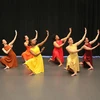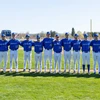With the “splicing” of a giant double-helix DNA model, the State University of New York at Fredonia officially ushered in a new era in science teaching and learning on Oct. 17.
Fredonia President Virginia Horvath led hundreds of students, alumni, faculty, staff, administrators and community members in a celebration of the stunning, 92,000-square-foot, four-story Fredonia Science Center. Surrounded by a beautiful courtyard and connected to Houghton Hall, it will vastly improve the teaching, learning and research opportunities within the STEM (Science, Technology, Engineering and Mathematics) disciplines across campus.

Fittingly, the event also served to kick off Homecoming Weekend, as the new facility included the dedication of nearly 30 spaces named by benefactors through the Fredonia College Foundation in honor of many accomplished alumni, retired professors, and friends of Fredonia. Many alumni also played a key role in the facility’s planning and design via their roles on Fredonia’s Natural Science Advisory Committee.
A musical performance began the ceremony, in the form of an original composition created especially for the event by Associate Professor Rob Deemer of the School of Music. Titled, “The Light of Things,” and inspired by William Wadsworth’s poem, “The Tables Turned,” it featured nearly 200 student vocalists, saxophonists and trombonists who were located throughout the atrium, main staircase and second floor foyer.
The new facility serves about 500 students majoring in Biology, Chemistry, Biochemistry, Molecular Genetics, Environmental Science, Medical Technology, Exercise Science and Science Education. It showcases students as they work alongside faculty mentors in a facility built to spotlight the art of science, including classrooms and laboratories with glass walls facing inside corridors. It features flexible spaces that let students move seamlessly from lectures to hands-on learning, including a main auditorium that allows for an instantaneous switch to small-group, collaborative learning scenarios and applied learning. The new center encourages interdisciplinary research and teaching, and includes plenty of social learning spaces, such as a café and study alcoves, to spark creative collaboration.
There are a total of 16 research labs, 10 teaching labs, two computer labs, two classrooms, a 120-seat auditorium, a café adjacent to the main lobby, a student reading room, a second-floor outdoor terrace, three
conference rooms, an energy efficient greenhouse and an observatory. The beautifully designed courtyard paving is laid out to resemble geologic strata reaching out to the Science Quad.



